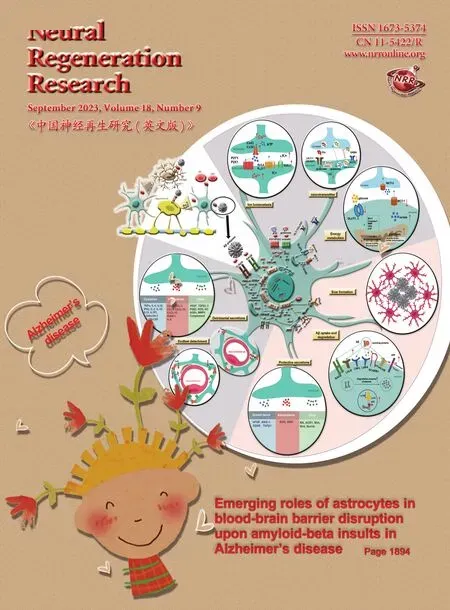中国神经再生研究(英文版)
Reviews
- Mesenchymal stem cells, extracellular vesicles, and transcranial magnetic stimulation for ferroptosis after spinal cord injury
- Inducing prion protein shedding as a neuroprotective and regenerative approach in pathological conditions of the brain: from theory to facts
- Extracellular vesicles as a potential therapeutic for agerelated macular degeneration
- Use of mesenchymal stem cell therapy in COVID-19 related strokes
- Brain organoids are new tool for drug screening of neurological diseases
- Emerging roles of astrocytes in blood-brain barrier disruption upon amyloid-beta insults in Alzheimer’s disease
- External anal sphincter electromyography in multiple system atrophy: implications for diagnosis, clinical correlations, and novel insights into prognosis
- New insights into the biological roles of immune cells in neural stem cells in post-traumatic injury of the central nervous system
- Gait analysis in swine, sheep, and goats after neurologic injury: a literature review
- Reviving the use of inhibitors of matrix metalloproteases in spinal cord injury: a case for specificity
- Mechanisms and treatment strategies of demyelinating and dysmyelinating Charcot-Marie-Tooth disease
Corrigendum
Perspectives
- Tissue optical clearing for neural regeneration research
- Effect of caffeine in the intraventricular hemorrhage of the preterm newborn
- Transcranial photobiomodulation with near-infrared light: a promising therapeutic modality for Alzheimer’s disease
- Microglial metabolic reconfiguration provides a new strategy for the treatment of Alzheimer’s disease
- Oxidative stress: culprit or consequence in Alzheimer’s amyloidopathy
- Immunological role of sulfatide in the pathogenesis of multiple sclerosis
- Neurodevelopmental defects as a primer of neurodegeneration: lessons from spinal muscular atrophy and Huntington’s disease
- Gene-modified neural progenitor cells for the treatment of neuropathic lysosomal storage diseases
Research Articles
- Serum response factor promotes axon regeneration following spinal cord transection injury
- Neuroprotective effects of meloxicam on transient brain ischemia in rats: the two faces of anti-inflammatory treatments
- Age-related hearing loss accelerates the decline in fast speech comprehension and the decompensation of cortical network connections
- C-X-C chemokine receptor type 7 antibody enhances neural plasticity after ischemic stroke
- miR-181b promotes angiogenesis and neurological function recovery after ischemic stroke
- Low-temperature 3D-printed collagen/chitosan scaffolds loaded with exosomes derived from neural stem cells pretreated with insulin growth factor-1 enhance neural regeneration after traumatic brain injury
- Injectable collagen scaffold with human umbilical cordderived mesenchymal stem cells promotes functional recovery in patients with spontaneous intracerebral hemorrhage: phase I clinical trial
- Photobiomodulation provides neuroprotection through regulating mitochondrial fission imbalance in the subacute phase of spinal cord injury
- Heat shock factor 1 promotes neurite outgrowth and suppresses inflammation in the severed spinal cord of geckos
- Inhibiting 5-hydroxytryptamine receptor 3 alleviates pathological changes of a mouse model of Alzheimer’s disease
- Genetic modification of miR-34a enhances efficacy of transplanted human dental pulp stem cells after ischemic stroke
- Single-nuclei RNA sequencing uncovers heterogenous transcriptional signatures in Parkinson’s disease associated with nuclear receptor-related factor 1 defect
- 5-Hydroxytryptamine: a potential therapeutic target in amyotrophic lateral sclerosis
- Transcriptional regulatory network during axonal regeneration of dorsal root ganglion neurons: laser-capture microdissection and deep sequencing
- Suppressing high mobility group box-1 release alleviates morphine tolerance via the adenosine 5'-monophosphate-activated protein kinase/heme oxygenase-1 pathway
- Fasting produces antidepressant-like effects via activating mammalian target of rapamycin complex 1 signaling pathway in ovariectomized mice
- Survival of rat sciatic nerve segments preserved in storage solutions ex vivo assessed by novel electrophysiological and morphological criteria

